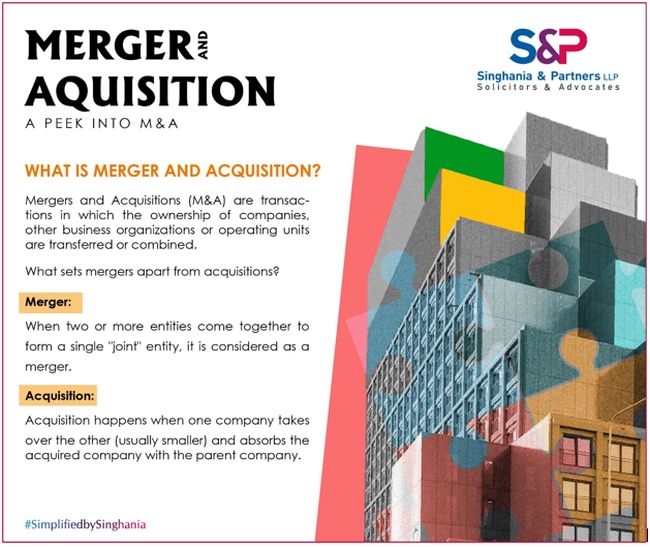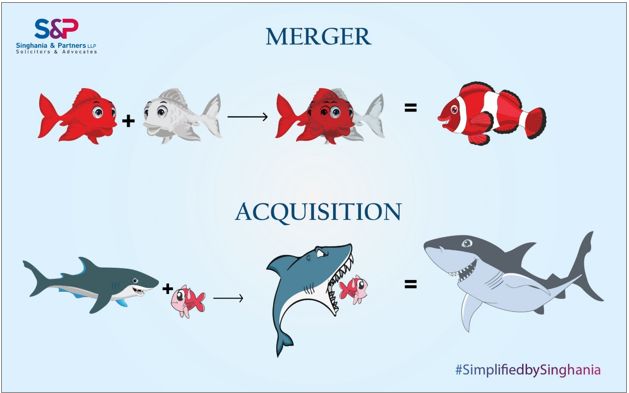- within Intellectual Property, Energy and Natural Resources and Real Estate and Construction topic(s)
- with readers working within the Retail & Leisure and Construction & Engineering industries

As the world enters into the era of globalization, significant changes are being observed across countries everywhere, in a way the companies across the world conduct business and strive to bloom. When a company decides to boost up its corporate performance and dominate the market sector in which it conducts its business, the thought of merging or acquiring a company that benefits both corporations can be extraordinarily seductive.
India recently recorded a deal-making spree of more than $82 million through M&A according to data compiled and reported by Bloomberg in June 2022. That is more than twice the previous record of $38.1 billion in the third quarter of 2019 despite significant geopolitical and financial challenges around the world. This makes M&A a hot topic of discussion not just in India but across the world.
What is Merger and Acquisition (M&A) ?
A merger happens when two companies (usually of similar size)
combine to form a single entity.
In other words, it is a fusion of two or more companies whereby
the identity of one or more is lost resulting in a single
company.
Eg. the Merger of two telecom giants, Vodafone and
Idea now called 'Vodafone Idea Ltd'.
An acquisition happens when a larger company acquires a smaller company and absorbs the smaller one. It is the purchase by one company of controlling interest in the share capital of another existing company. After acquisition, the management of both the companies change, but they retain their individual legal character.

Takeover – a Friendly or a Hostile
approach to Acquisition?
A takeover is simply the purchase of a company (target) by another
(acquirer). It is a common practice that is achieved through mutual
agreement or a hostile battle. Whatever it may be, the result is
always a single company.
Generally, a big company acquires a smaller one that is struggling
to sustain itself due to competition in the market. The acquirer
analyses the target company and initiates a takeover after it
believes that it can boost their business and make them
profitable.
There is often confusion between a 'Hostile
takeover' and a 'Friendly
takeover' This has been addressed here in an
uncomplicated manner.
Hostile Takeovers: This happens when the
acquirer secretly buys the shares of non-controlling shareholders
from the open market and gradually acquires the majority stake in
the target company.
An example could be L&T's hostile takeover of Mindtree
Limited when India witnessed its first hostile
takeover.
Friendly takeovers: This happens when the
management of both firms approves the takeover and advises the
shareholders to vote in favour of the deal. The management and
stakeholders voluntarily agree to sell a significant share to the
acquirer.
Example could be Tata's friendly takeover of 1Mg by
acquiring a 60% stake for $230 million.
All mergers and acquisitions have the same primary goal: to create
synergy between the merging
companies. A synergy in this context means that they want to be
more valuable together than the sum of the market values of their
individual companies. The success of M&A is determined by
whether or not this synergy is achieved. Through M&A the companies want to achieve the
following:
- Higher Growth: Companies are always striving to become bigger and better. Such growth may take a long time organically, but M&A allows them to achieve it quickly.
- Domination: Companies frequently engage in M&A in order to dominate their market sector. However, if such M&A creates a monopolistic situation in the market, they must answer to the regulatory authorities.
- Tax Benefits: Acquiring a company with tax
losses enables the acquiring company to use this fact to lower its
tax liability. Although this may be an implicit rather than an
explicit motive.
Acquiring a company with tax losses enables the acquiring company to use this fact to lower its - Economies of Scale: This refers to the reduced costs per unit that is the result of the increased total output of the product, which often happens during mergers.
- Acquiring new technology: Companies often buy smaller companies with unique technology. This helps them to gain a competitive edge in the market.
- Improved market reach and industry visibility: Companies often buy other companies to reach and tap new markets and surge their earnings. A merger expands to the marketing and distribution of two companies giving them new sales opportunities. Also, M&A helps companies in the investment community: usually a bigger company finds it easier to raise funds than a small company.
- Diversification: Companies often feel they need to diversify their cash flow in order to reduce losses during a market slowdown. Acquiring a company dealing in a non-cyclical industry helps companies to reduce market risk.
M&A take place:
- by purchasing assets.
- by purchasing common shares.
- by exchange of shares for assets.
- by exchanging shares for shares.
M&A include a number of different transactions such as:
- Mergers
- Acquisitions
- Amalgamation
- Consolidations
- Tender offers
- Purchase of assets
M&A is one of the most effective ways for businesses to go past some of their existing problems and develop and succeed in the market. Businesses that have undergone significant M&A restructuring, expanded operations, and other synergies have improved their competitiveness and established a global footprint. Next in this series of M&A, we shall look into some of the most common types of Mergers to understand the number of ways by which mergers between the companies are structured based on the relationship between the companies involved in the deal.
The content of this article is intended to provide a general guide to the subject matter. Specialist advice should be sought about your specific circumstances.


